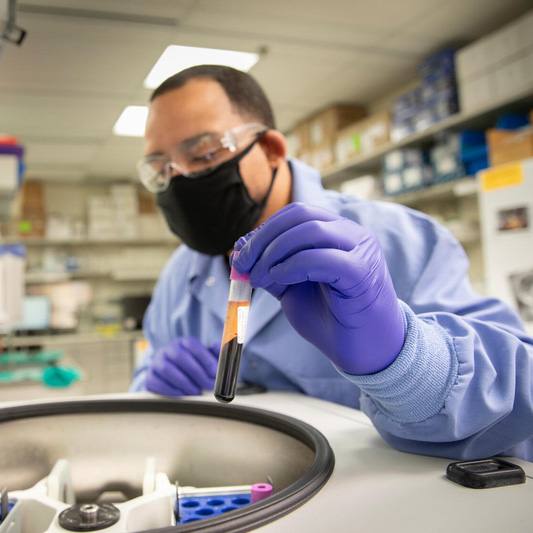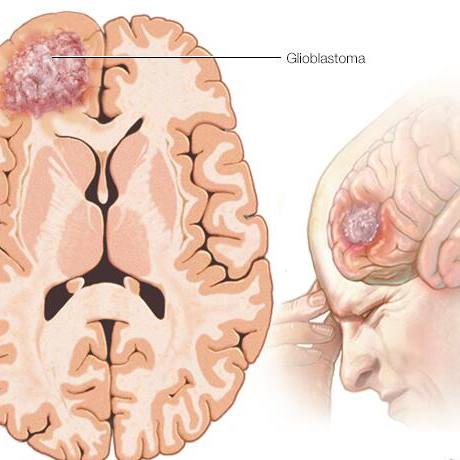-
Research
Science Saturday: Orthobiologics can be nature’s healing agents
Mayo Clinic physician-scientists are working on regenerative biotherapeutics such as orthobiologics and other regenerative bioinjectables to bring advanced procedures to more patients.
Orthobiologics are biological agents that stimulate healing when standard therapies don't work. Examples are platelet-rich plasma — platelets spun from a patient's blood that promote cell repair— and bone marrow aspirate concentrate that contains stem cells and many other cells that have shown potential for tissue regeneration.
"Orthobiologics are like nature's drug store," says Shane Shapiro, M.D., a sports medicine doctor and medical director of Mayo Clinic's Regenerative Medicine Therapeutic Suites in Florida. "Cells and growth factors that act as healing agents are taken from a person's own blood, manufactured, and given back to them. The American Orthopaedic Society for Sports Medicine reports that 66% of orthopedic surgeons are using platelet-rich plasma in their practice, and 70% of those physicians say they are increasing the use to complement standard care."
Advancing biologics was a key topic at the Mayo Clinic Symposium on Regenerative Medicine & Surgery 2023, sponsored by Mayo Clinic's Center for Regenerative Biotherapeutics. The Center is committed to training the future workforce about validated regenerative therapies to help heal patients around the world. During the session, panelists also discussed insurance and out-of-pocket expenses. The session was moderated by Dr. Shapiro, with panelists Saranya Wyles, M.D., Ph.D., a Mayo Clinic dermatologist; Cody Wyles, M.D., a Mayo Clinic orthopedic surgeon; and David Lott, M.D., a Mayo Clinic ear, nose and throat specialist.
Orthobiologics and the clinical practice of medicine
Platelet-rich plasma has been used in clinical practice for a number of other medical specialties, particularly musculoskeletal conditions, for over 15 years. The Centers for Medicare & Medicaid Services approved platelet-rich plasma as a treatment for chronic diabetic wounds. Mayo Clinic's Regenerative Medicine Therapeutic Suites in Florida and Arizona now offer it as a covered service for Medicare and Medicaid patients who qualify. Mayo's Wound Care Clinic in Rochester is exploring the possibility of offering platelet-rich plasma as an option for nonhealing diabetic wounds.
Clinical trials have found therapeutic potential in the injectable orthobiologics, but they have not yet achieved enough conclusive data to be covered by insurance.
"I have patients with arthritis coming in wanting to feel better so they can dance at their daughter's wedding before a planned hip replacement surgery that's months away," says Dr. Cody Wyles. "Because of the expense, they'll opt for a steroid injection rather than orthobiologic interventions. Steroids are cheap, easy to administer, and typically offer intermediate-term pain relief but are not a long-term or disease modifying therapeutic solution. Orthobiologics might be an option if steroids don't work."
Dr. Lott emphasizes research when presenting injectable biologics as an option to ease throat and voice ailments in patients with unmet needs.
"By the time people come to see me, they've pretty much exhausted all standard options," says Dr. Lott. "I'll explain to them the risks and benefits of regenerative technologies. I let them decide whether to proceed with some of the options that are available."
As a dermatologist, Dr. Saranya Wyles has many conversations about out-of-pocket expenses. It's a talk she has when patients are interested in platelet-rich plasma for male- or female-patterned baldness.
"I explain to them the frequency of the injections and that it's private pay," says Dr. Saranya Wyles. "We talk about patient variability, and I tell them there currently isn't a definitive way to quantify the benefit in terms of hair regrowth, but we are studying some options."
Three suggestions for improving injectable orthobiologics
The panelists suggested three ways to strengthen the case for advancing platelet-rich plasma and bone marrow aspirate concentrate :
Address standardization
Different providers use different machines to make platelet-rich plasma. As a result, the manufactured platelets can vary in strength and quality from one manufacturer to the next.
"We may not be able to control manufacturing at other organizations, but one thing we can control is the quality of cells we use," says Dr. Lott. "If we consistently meet specific criteria and quality control for blood and cell collection, that might provide more important data." Dr. Lott is also the associate director of the Mayo Clinic Center for Regenerative Biotherapeutics in Arizona.
Increase understanding of patient outcomes
Orthobiologics such as platelet-rich plasma have been shown to provide relief for osteoarthritis in many patients, but it doesn't work for everyone. Each person's biological condition is different, which could contribute to inconsistent outcomes."
"Platelet-rich plasma varies from patient to patient and is influenced by lifestyle factors. For example, if a person is dehydrated or undernourished from the night before, or has eaten too much salt, their plasma is going to be different," says Dr. Saranya Wyles. "That can create variability where platelet-rich plasma works great for some patients but not for others."
Establish more scientific and real-world evidence
The Mayo Clinic physicians agree that more study is needed to provide additional evidence of the therapeutic benefits of platelet-rich plasma and bone marrow aspirate concentrate.
The 21st Century Cures Act allows the FDA to consider real-world evidence such as data from health records, medical claims or product or disease registries to support the regulatory approval process.
A recent Mayo Clinic study of real-world evidence in the Orthopaedic Journal of Sports Medicine found that adding bone marrow aspirate concentrate after rotator cuff repair surgery could have an impact on the need for follow-up revision surgery in some patients.
"Mayo Clinic continues to collect data from consenting patients and study the effectiveness of orthobiologics. We hope to compile evidence to better understand the precise therapeutic mechanisms of action," says Dr. Shapiro.
Over time, stronger scientific evidence and better understanding of the variability of orthobiologics could improve patient access and bring new care options at Mayo Clinic and beyond.
###
Related posts:
Real-world evidence study of regenerative medicine and shoulder surgery
American Medical Society for Sports Medicine position on regenerative medicine
Mayo Clinic orthopedist shares perspective on regenerative medicine
Studies related to bone marrow aspirate concentrate and platelet-rich plasma:
"Quantitative T2 MRI Mapping and 12-Month Follow-up in a Randomized, Blinded, Placebo Controlled Trial of Bone Marrow Aspiration and Concentration for Osteoarthritis of the Knees" "Preparing Regenerative Therapies for Clinical Application: Proposals for Responsible Translation"












